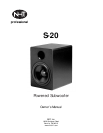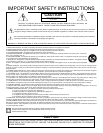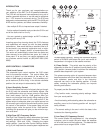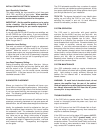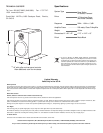INITIAL CONTROL SETTINGS:
Input Sensitivity Selection:
This switch affects the input sensitivity of all three sets
(XLR, TRS and RCA) of input jacks. When satellites
are connected to the S-20, the subwoofer takes over
as the master sensitivity control for the system.
IMPORTANT: Set the satellite speakers you're using
to the +4 setting. Set the sensitivity on the S-20 to
the appropriate setting for your source equipment.
HP Frequency Selection:
If you are using NHTPro M-00 monitors as satellites, set
the HP FREQ to the 110Hz setting. If you use a different
brand of powered satellites try setting the switch to 110
Hz when the satellite woofer size is 5” or smaller and
80Hz if larger than 5”.
Subwoofer Level Setting:
The level you select will depend largely on placement.
We suggest you start with this control in the 12 o'clock
position. Move the control in a clockwise direction to
increase bass output and counterclockwise to decrease
it. Adjust the level so that the S-20 seamlessly integrates
with the satellites, ie. you can tell it's operating but can't
“hear” it as a separate entity.
Low Pass Frequency Setting:
Getting this setting right may take a little time. Using a
variety of demo material you are very familiar with, start
with the control in the 12 o'clock position. If the bass
sounds too “punchy”, turn the control counter clockwise
towards 80Hz. If the bass sounds thin, turn the control
clockwise towards 110Hz.
SUBWOOFER PLACEMENT:
Where you locate the S-20 subwoofer will have a pro-
found effect on the system's performance. Unfortunately,
there are no hard and fast rules to find the best location.
If you have some flexibility, we encourage you to experi-
ment. The following guidelines should help you in your
placement decisions:
Placement near walls and corners will reinforce low fre-
quencies; conversely, placement out into open space will
add definition, but will reduce bass weight and extension.
Ideally, the subwoofer should be adjusted so that you
hear the additional bass extension, but cannot localize
the subwoofer itself. The subwoofer should be placed
somewhere in the same plane as the left and right moni-
tors. Listen as you go, using a wide variety of program
material. Jazz recordings with acoustic bass and piano
are particularly helpful in determining location, sub level
and crossover settings. Transparency and integration
are the goals.
The S-20 subwoofer amplifier has a number of controls
which can help you determine optimal placement. A little
time spent experimenting with these options should yield
just the right solution for your installation.
TECH TIP: The bypass foot switch is very helpful when
setting up and tuning the S-20 to your room. When
switching the woofer in and out, no tonal difference
should be noticeable, just bass or no bass.
SYSTEM OPERATION
The S-20 used in conjunction with good satellite
monitors, like the M-00's, can play very loud with low
distortion. Although designed to handle a wide range of
listening levels, every speaker has its limits. Harsh
breakup is an indication your monitors or the subwoofer
have exceeded their output limits. Excessive boosting of
bass, treble or equalizer controls can worsen the
problem. If you hear continuous distortion or feel heat
emanating from the drivers, reduce the level immediate-
ly. Most speaker damage occurs from sustained high
volume levels, not from transient sounds or brief musical
peaks. Listening at high volume levels is potentially dan-
gerous and can lead to permanent hearing loss,
especially when listening in the near-field. Protect your
ears and use common sense.
SYSTEM MAINTENANCE
Your S-20 subwoofer needs no regular maintenance.
The S-20 cabinet is finished with a durable, powder-coat
paint. Light dusting is usually sufficient, although the
cabinet can be cleaned with a non-abrasive, water
based, cleaner.
WARNING: To avoid risk of electrical shock, do not
remove the amplifier from the rear of the cabinet.
Refer all repairs to a qualified authorized service cen-
ter. Always disconnect the S-20 from the AC power
source prior to any maintenance.
TROUBLESHOOTING
If the S-20 fails to operate when the Power Switch is
turned on, thoroughly check the power cord, input and
output connections
If the S-20 turns on but the LED indicator fails to illumi-
nate, mis-wiring or a power surge may have caused the
amplifier to become damaged.
If the S-20 turns on but its status LED appears AMBER,
the unit has gone into FAULT (protect mode), which
could be caused by incorrect wiring, short circuits, or
excessive volume. Turn off the Power Switch on the sub-
woofer for two or more seconds to reset. If this doesn’t
help, contact NHT customer service.
4



